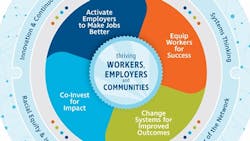While I promise not to quote the percentage of how many people have said they are going to leave their jobs, let's just agree that it's a large number.
As the pandemic is getting under control, for the most part, people are evaluating their jobs ( and their lives) and are coming to the conclusion that they aren't satisfied with either the work they are doing or how it's being done.
“While the intent after the recession in 2008 was just to get everyone back to work, we need to have a wider view this time around,” explains Amanda Cage, CEO of The National Fund for Workforce Solutions. “The intent now should be to ensure that employees are getting high-quality jobs and ensuring workforce equity.”
Her organization, through a network of 30 collaboratives across the country, is working with employers to help them create better jobs.
They employ four solutions to advance workforce strategies:
1. Activate employers to help them design jobs that will help recruit and retain workers.
2. Equip workers for success, which includes both traditional methods such as education and on-the-job training, but also help employers respond to the call for more diversity.
3. Be a change agent for the entire workforce ecosystem by exploring new ways of further strengthening the relationship between employers and educational institutions.
4. Provide funding and co-investments to organizations that are making progress in the field.
To do this, the organization has found a framework of "job quality that is on a continuum so that the companies can see themselves in this framework and then choose what works for them,” Cage says.
The framework has three basic tenants:
1) Core Job Elements – pay, stability and benefits
2) Opportunity – investing in workers by advancing their skills
3) Worker Voice – employees need to be empowered by understanding that their voice will be heard, and actions will be taken.
To ensure that these elements are the foundation of good work practices, companies need to first truly understand the needs of their workforce. "Companies must determine what is important to their workforce. Doing this doesn’t cost employers a lot, and it has a huge impact on a number of workforce metrics, including employee engagement, job satisfaction, attraction and retention.”
About the Author
Adrienne Selko
Senior Editor
Email [email protected]
Adrienne Selko is also the senior editor at Material Handling and Logistics and is a former editor of IndustryWeek.

